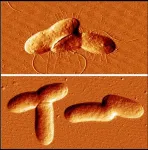Scientists engineer substrates hostile to bacteria but friendly to cells
Nanostructured anodic alumina surfaces can be used to culture cells and tissue
2025-01-11
(Press-News.org)
Tokyo, Japan – Researchers from Tokyo Metropolitan University have created nanostructured alumina surfaces which are strongly antibacterial but can be used to culture cells. They found that anodic porous alumina (APA) surfaces prepared using electrochemistry in concentrated sulfuric acid had unprecedented resistance to bacterial growth, but did not hamper cell cultures. The team’s technology promises to have a big impact on regenerative medicine, where high quality cell cultures without bacterial contamination may be produced without antibiotics.
Surfaces that resist bacterial contamination play a vital role in public health and our daily lives. While this might be achieved with powerful antibiotics and chemicals, this entails a negative environmental impact, health hazards, as well as the potential emergence of dangerous, antibiotic-resistant strains. We need alternative ways of controlling the spread of bacterial pathogens.
This is where nanostructured surfaces come in. In the early 2010s, it was shown that the naturally formed nanostructure on the wings of cicada and dragonfly wings can resist bacterial contamination. The structures damage the cell membrane of bacterial cells and prevent them from spreading. Thus, scientists have been on the lookout for ways to cheaply manufacture artificial surfaces which might achieve the same effect.
A team of researchers led by Professor Takashi Yanagishita from Tokyo Metropolitan University have been exploring the use of anodic porous alumina (APA). When polished aluminum surfaces are dipped in an electrochemical cell under certain conditions, the surface is coated with a well-ordered array of porous pillars of alumina (aluminum oxide). These needle-like pillars are just the right size to be deadly to bacteria, making the surfaces strongly antibacterial.
Now, the team have perfected their recipe, finding that APA surfaces prepared in concentrated sulfuric acid have antibacterial properties which significantly outperform existing surfaces. Crucially, they discovered that the surfaces were not hazardous to biological cells cultured on them. In normal cell cultures, antibiotics may be added to the culture medium to prevent the incidence of bacterial contaminants. This has the major drawback of being useless against antibiotic resistant bacteria; in fact, their overuse might again lead to the emergence of more resistant strains. This is not the case with APA surfaces. Cultures may be safely carried out without antibiotic additives.
The team’s discovery is good news for regenerative medicine, where cells are cultured in the lab before being introduced to a patient to treat tissue and organ damage. Any bacterial intruder in the cells may have dire consequences for sick patients: this usually entails specialized and costly sterile environments. The team believe that their new substrates might enable antibiotic-free cell culture in a wider range of settings, potentially revolutionizing the scale at which patients may be treated, as well as how we do scientific experiments.
This work was partially supported by JSPS KAKENHI Grant Number JP24K01219.
END
[Attachments] See images for this press release:

ELSE PRESS RELEASES FROM THIS DATE:
2025-01-11
A new tablet combining albendazole and ivermectin is safe and more effective than albendazole alone in treating Trichuris trichiura and other soil-transmitted helminths (STH), according to a clinical trial conducted by the STOP consortium and led by the Barcelona Institute of Global Health (ISGlobal), a centre supported by “la Caixa” Foundation. The findings, published in The Lancet Infectious Diseases, open opportunities to improve the control of these neglected tropical infections, which affect around ...
2025-01-10
In an effort to close the gap in neurological outcomes for underserved populations, a UTHealth Houston project funded with $2.9 million from the National Institutes of Health (NIH) will engage community partners to improve the design of clinical trials.
Neurologic conditions including stroke, Parkinson’s disease, and vascular cognitive impairment and dementia contribute to the leading causes of death and disability in the U.S. The goal of the project is to build an infrastructure for community-engaged research interventions for those three neurologic conditions affecting brain health.
“Historically, clinical trials for neurological conditions haven’t ...
2025-01-10
Depression can affect anyone. It is common, and in many cases severe. These days, there are good treatments available, typically involving a combination of psychotherapy and medication. However, finding the right treatment can take some time. Not everyone responds equally well to every medication. Researchers at six European university medical centers, led by Charité – Universitätsmedizin Berlin, teamed up to accelerate the process of arriving at solid findings relating to both new and known treatments. The key will be a joint study design, supported over the ...
2025-01-10
Researchers from the Hong Kong Polytechnic University, alongside mainland collaborators, have uncovered an unexpected phenomenon: severe wintertime ozone (O₃) pollution in Lanzhou, China, driven primarily by alkene emissions from local petrochemical industries. Traditionally associated with warm weather and strong solar radiation, hourly O₃ levels exceeding 100 ppbv were recorded during cold January days in 2018, peaking at an alarming 121 ppbv.
Using an advanced photochemical box model, the study identified alkene ozonolysis as ...
2025-01-10
East Hanover, NJ – January 10, 2025 – The employment-to-population ratio for people with disabilities has remained stable over the past 15 months amid historically high levels, with recent data suggesting a modest but encouraging upward trend, according to today’s January 2025 National Trends in Disability Employment monthly update (nTIDE) issued by Kessler Foundation and the University of New Hampshire’s Institute on Disability (UNH-IOD).
Month-to-Month nTIDE Numbers (comparing November 2024 to December 2024)
Based on data from the U.S. Bureau of Labor Statistics (BLS) ...
2025-01-10
A recent commentary article by researchers from Northwestern University, Harvard University, and The University of Texas at San Antonio highlights the significant but overlooked environmental and social impacts of Generative Artificial Intelligence (GenAI). Published in Environmental Science and Ecotechnology, the research underscores the urgent need for sustainable practices and ethical governance as GenAI technologies proliferate.
The study reveals the environmental toll of GenAI development, with hardware production such as GPUs and data centers consuming ...
2025-01-10
FOR IMMEDIATE RELEASE
January 10, 2025
Contact:
Jillian McKoy, jpmckoy@bu.edu
Michael Saunders, msaunder@bu.edu
##
Lower Access to Air Conditioning May Increase Need for Emergency Care for Wildfire Smoke Exposure
As Los Angeles County battles the most destructive wildfires in its history, a new study suggest that US policies should prioritize equity and education regarding the measures people can take to protect themselves from the harmful pollutants in wildfire smoke.
People who have limited access to air ...
2025-01-10
If your teeth have ever felt fuzzy after skipping a brushing, you’ve encountered biofilm—a slimy bacterial layer that clings to surfaces. In medical settings, biofilms make infections harder to treat when they form protective shields for bacteria on devices like catheters and implants.
UC Riverside scientists have now discovered a chemical that plants produce when they're stressed prevents biofilm from forming. The breakthrough offers potential advances in healthcare as well as preventing equipment corrosion in industrial settings.
“In simple terms, biofilms are communities ...
2025-01-10
Hinda and Arthur Marcus Institute for Aging Research investigators at Hebrew SeniorLife have launched a large clinical food trial to test whether a combination of probiotics and prebiotics (BondiaÒ or SBD111) developed by Solarea Bio will help manage bone health in women aged 60 years and above. The first participants have joined the study and the Institute seeks additional women for the 18-month effort.
“I am very happy to be involved in this important research to help with bone health in women,” says study participant Kathy ...
2025-01-10
From mapping ore to predicting slope behavior and reclaiming land, mining is a rapidly evolving technological industry. Yet planning and operations have not necessarily kept up with the advancements.
With $1.25 million from the National Institute for Occupational Safety and Health, or NIOSH, mining and geological engineering researchers in the University of Arizona College of Engineering are boosting their efforts to better align technology and planning for improved safety and productivity.
The award from the institute, part of the Centers for Disease Control and Prevention, will fund the research ...
LAST 30 PRESS RELEASES:
[Press-News.org] Scientists engineer substrates hostile to bacteria but friendly to cells
Nanostructured anodic alumina surfaces can be used to culture cells and tissue




